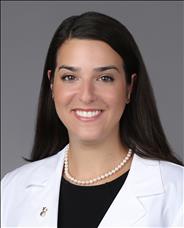

Introduction: Balancing Intervention with Observation
Managing thyroid cancer requires a nuanced approach that balances intervention with observation. While the majority of thyroid cancers present a favorable prognosis, clinical decision-making requires precision, from initial workup and risk stratification to surgical planning and adjuvant therapy selection.

Meghan Crawley, M.D
A recent Baptist Health Doc-to-Doc podcast featured Meghan Crawley, M.D., a head and neck surgical oncologist at Baptist Health Miami Cancer Institute, and Rachel Slotcavage, M.D., an endocrine surgeon at Lynn Cancer Institute, part of Baptist Health Cancer Care, at Boca Raton Regional Hospital. The two physicians explored current perspectives on diagnostics, molecular testing and treatment protocols for differentiated thyroid cancer.
Initial Workup and Diagnostics
The increasing incidence of thyroid nodules, often discovered incidentally on imaging, mandates a standardized and efficient diagnostic protocol. An initial evaluation should prioritize high-yield studies while avoiding unnecessary tests that can contribute to patient anxiety and resource misuse.
“The single most important study to obtain is going to be a thyroid ultrasound,” states Dr. Slotcavage. “And you’re going to want to ensure that includes lymph node mapping of both the central neck and the lateral compartments.” This provides critical data on nodule characteristics for TI-RADS classification and assesses for regional disease.
Dr. Slotcavage also advises against the routine preoperative use of PET scans or thyroglobulin tests, which have limited utility in the initial diagnostic setting for differentiated thyroid cancer. “Those are things that we use in postoperative surveillance but they don’t really help us guide treatment at all in the workup in the preoperative setting,” she explains.

Rachel Slotcavage, M.D..
Cross-sectional imaging, such as a contrasted CT scan, is reserved for cases with clinical suspicion of advanced disease. Indications include:
- New-onset voice changes concerning for vocal cord paralysis.
- Hemoptysis or significant shortness of breath.
- Palpable cervical lymphadenopathy.
The Role of Molecular Testing
For indeterminate nodules classified as Bethesda III or IV, molecular testing has become an essential tool for risk stratification. It offers a personalized risk assessment that can guide clinical decisions and help avert repeat biopsies or unnecessary surgeries.
Dr. Crawley finds it “useful for indeterminate nodules” to clarify risk and counsel patients. If results indicate a higher than 50% risk of malignancy, she may recommend a diagnostic lobectomy, which also serves as definitive treatment in many cases.
Dr. Slotcavage adds that molecular markers are particularly valuable for patients who are poor surgical candidates, as a benign result can help avoid an operation. It is crucial, however, to interpret these results within the complete clinical context. A BRAF mutation, for example, is not universally predictive of aggressive behavior but it is a critical biomarker for guiding immunotherapy in unresectable or anaplastic thyroid cancers.
Surgical Management: Lobectomy vs. Total Thyroidectomy
Surgery remains the primary treatment modality for differentiated thyroid cancer. The decision between a lobectomy and a total thyroidectomy depends on tumor characteristics, patient comorbidities, and patient preference after a thorough discussion of risk.
“I think a lot of patients do just say, ‘take the whole thing out,’” Dr. Crawley observes, noting that patient anxiety about recurrence or the need for a second surgery in the presence of contralateral nodules often drives the decision toward total thyroidectomy.
Dr. Slotcavage frames the conversation around the patient’s personal risk tolerance. “If you are someone who is going to be constantly palpating your neck, looking in the mirror, worried... then total thyroidectomy is the answer,” she says. For many low-risk unifocal tumors, however, a lobectomy is considered a curative procedure.
Adjuvant Therapy: The Evolving Use of RAI
The application of radioactive iodine (RAI) has become increasingly selective. Current American Thyroid Association (ATA) guidelines recommend reserving RAI for high-risk tumors, such as those with large size, extrathyroidal extension, or significant nodal metastases.
“We now know that we were giving a radioactive therapy...to a lot of people who truly didn’t need it,” Dr. Slotcavage states. She emphasizes that for the majority of patients with low or intermediate-risk cancers, surgery alone is curative. This shift minimizes exposure to RAI-associated risks, including effects on fertility and salivary gland function, and reduces the overall treatment burden.
Emerging and Experimental Therapies
The therapeutic landscape for thyroid cancer continues to evolve, with a focus on less invasive options.
One such therapy is radiofrequency ablation (RFA). While established for symptomatic benign nodules, RFA is being explored for cancerous lesions. Its current use in cancer is experimental, primarily for low-volume, metastatic lateral neck disease in patients who have maximized surgical and RAI options.
“Patient selection is very important,” cautions Dr. Slotcavage, highlighting the risk to adjacent structures like the recurrent laryngeal nerve and the palliative nature of the treatment in this context.
Conclusion: A Future of Personalized, De-escalated Care
The consensus among experts points toward a future of “treatment reduction,” as Dr. Crawley terms it. This paradigm involves avoiding over-testing and overtreatment through more precise risk stratification and the adoption of less invasive therapies.
“I think there’s a lot of opportunity moving forward to really be able to tailor our therapy to the patient’s exact disease presentation,” Dr. Slotcavage concludes. By leveraging advanced diagnostics and adhering to evidence-based guidelines, clinicians can reassure most patients that their thyroid cancer can be cured with a single operation, reserving more aggressive, multimodal therapies for the small subset of patients who require them.

